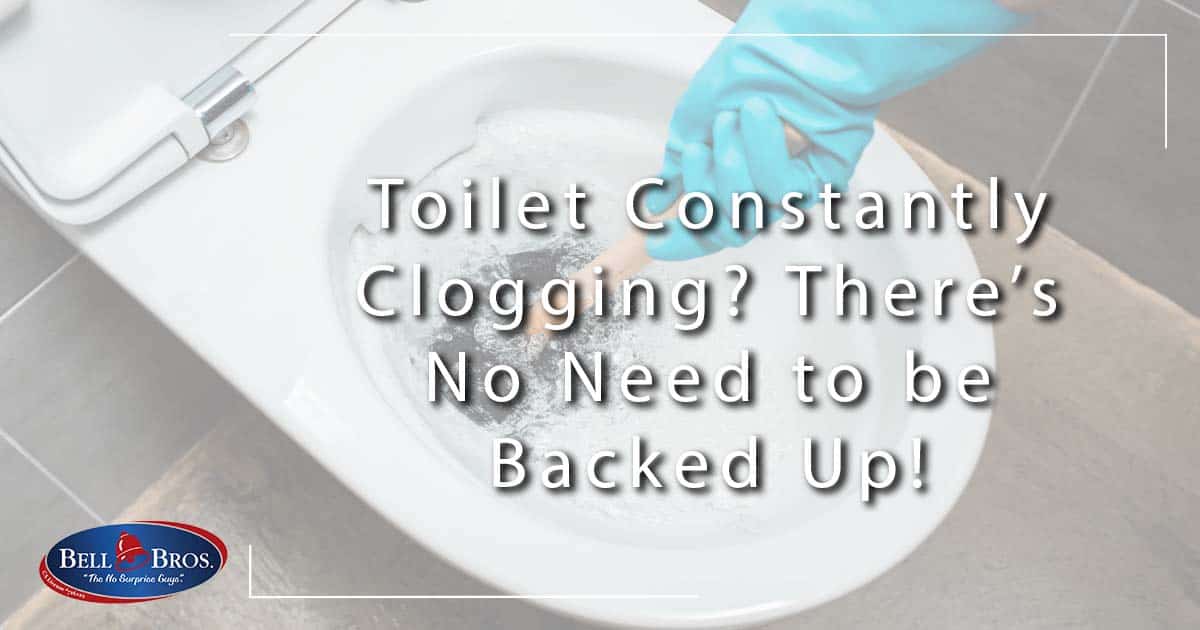Toilet Constantly Clogging? There’s No Need to be Backed Up!
 Do your toilets always seem to be stuck in a perpetual state of backing up? Are you continually unclogging them with all too frequently plunger jobs? It’s okay. There is hope!
Do your toilets always seem to be stuck in a perpetual state of backing up? Are you continually unclogging them with all too frequently plunger jobs? It’s okay. There is hope!
Indoor plumbing is no longer a modern convenience that makes everyday life easy. It’s a necessity! When your bathroom fixtures don’t function like they’re supposed to, it can be frustrating and time-consuming.
Some toilet clogs can be solved with a simple plunger job or another DIY fix. But a recurring clog could be the symptom of a serious plumbing issue in your home that requires plumbing maintenance by professionals.
The Bell Brother’s crew put together a few scenarios to troubleshoot your backed-up bathroom!
You’re Flushing the Wrong Things
There are only two things that should be flushed down any toilet, ever. One is human waste, and two is toilet tissue.

If you’re in the habit of flushing anything else, it’s time to put a stop to it. Even items that are labeled as “toilet friendly” or “flushable” can cause clogging. Avoid flushing these common items:
- Baby wipes
- Cleaning wipes
- Napkins
- Paper towels
- Ear swabs
- Sweeper pads
- Feminine products
- Make-up remover wipes
- Wet mop sheets
These objects can become trapped in your pipes and cause frequent clogging.
Main Sewer Line Is Damaged
The pipe that connects your home’s plumbing to an in-ground septic tank or the local sewer system is the main sewer line. When this line become damaged in any way, it can cause reduced flow and even full obstruction.
Though they’re placed underground and safe from the elements, it is still vulnerable to a few things. Tree roots that grow too close to the mainline can wrap around the pipe and restrict the flow.
If your mainline pipe is damaged or clogged, all the toilets in your home will clog as well, indicating a bigger problem. Contact your local Sacramento plumber to schedule drain clearing as soon as possible to avoid further damage.
You’re Using Too Much Toilet Paper
Using too much toilet tissue is a surefire way to clog your toilet, every time. We can be tempted to always blame young children for this but really, anyone can be guilty of overzealous paper use.
Remember, the more toilet tissue you flush, the more likely your commode is to clog. A few squares of standard toilet tissue are enough to clean up. A simple change in habits is an easy way to save time unclogging toilets as well as save money on unnecessary amounts of toilet tissue.
NOT THE PRECIOUS TOILET PAPER #quarantinecats pic.twitter.com/vvJnSeYNcK
— Jessi Davin (@jessithebuckeye) March 16, 2020
The toilet tissue industry has gone through some significant changes over the years. It comes in many sizes, types, and varying degrees of softness. There are even specialty toilet tissues that are eco-friendly and designed for use with a septic tank system or travel trailer.
If you prefer the fluffy soft kind, it’s especially important to use it sparingly. The denser the tissue, the more difficult it will be to dissolve in your plumbing system. This will potentially set you up for immediate and future clogging.
Talk with your family and train young children about responsible toilet tissue use. Try economic folding techniques and avoid creating wads or balls of tissue. Keep an eye on young ones as they potty train to make sure excess tissue doesn’t find its way into the bowl. The next time you shop for toilet tissue, take the time to browse and select an option that may help alleviate your clogging issues.
Your S-Trap Is Clogged
Underneath most toilets at the back is an S-shaped or P-shaped that connects the toilet with the floor. This design is what keeps pungent gasses from escaping the drainpipes as well as keeping any foreign objects from getting into your main sewer line.
If there is a blockage in the S-trap, you will experience frequent clogging. But a simple plunger or auger job should clear it up. If the solution only lasts a day or two, it’s time to call a trusted plumber for drain cleaning services!
We hope one or more of these solutions helps resolve your clogging issues! If not, you may be facing a more serious plumbing maintenance or repair problem.

